
SAFETY/HANDLING
SAFETY/HANDLING OF WHEELCHAIRS
“Safety and Handling” of the wheelchair requires the close attentionofthewheelchairuseraswellastheassistant.This manual points out the most common procedures and tech- niques involved in the safe operation and maintenance of the wheelchair. It is important to practice and master these safe techniques until you are comfortable in maneuvering around the frequently encountered architectural barriers.
Use this information only as a “basic” guide. The techniques that are discussed on the following pages have been used successfully by many.
Individual wheelchair users often develop skills to deal with daily living activities that may differ from those described in this manual. Invacare recognizes and encourages each in- dividual to try what works best for him/her in overcoming architectural obstacles that they may encounter, however ALL WARNINGS and CAUTIONS given in this manual MUST be followed.Techniques in this manual are a starting point for the new wheelchair user and assistant with “safety” as the most important consideration for all.
STABILITY AND BALANCE
WARNING
ALWAYSwearyourseatpositioningstrap.Inasmuch astheSEATPOSITIONINGSTRAPisanoptiononthis wheelchair(YoumayorderwithorwithouttheSeat PositioningStrap),Invacarestronglyrecommends orderingtheSeatPositioningStrapasanadditional safeguard for the wheelchair user.
Toassurestabilityandproperoperationofyourwheelchair, you must at all times maintain proper balance. Your wheel- chair has been designed to remain upright and stable dur- ing normal daily activities as long as you do not move be- yond the center of gravity.
Virtually all activities which involve movement in the wheel- chair have an effect on the center of gravity. Invacare rec- ommendsusingseat/chestpositioningstrapsforadditional safety while involved in activities that shift your weight.
DO NOT lean forward out of the wheelchair any further than the length of the armrests. Make sure the casters are pointingintheforwardpositionwheneveryouleanforward. This can be achieved by advancing the wheelchair and then reversing it in a straight line.
COPING WITH EVERYDAY
OBSTACLES
Coping with the irritation of everyday obstacles can be alleviated somewhat by learning how to manage your wheelchair. Keep in mind your center of gravity to main- tain stability and balance.
A NOTE TO WHEELCHAIR
ASSISTANTS
When assistance to the wheelchair user is required, re- member to use good body mechanics. Keep your back straight and bend your knees whenever tipping the wheel- chair or traversing curbs, or other impediments.
WARNING
DO NOT attempt to lift the wheelchair by any re- movable (detachable) parts. Lifting by means of anyremovable(detachable)partsofawheelchair may result in injury to the user or damage to the wheelchair.
Also, be aware of detachable parts such as armrests or legrests. These must NEVER be used for
When learning a new assistance technique, have an ex- perienced assistant help you before attempting it alone.
PERCENTAGE OF WEIGHT
DISTRIBUTION
WARNING
DO NOT attempt to reach objects if you have to move forward in the seat or pick them up from the floor by reaching down between your knees.
Many activities require the wheelchair owner to reach, bend and transfer in and out of the wheelchair. These movements will cause a change to the normal balance, the center of gravity, and the weight distribution of the wheelchair. To determine and establish your particular safety limits, practice bending, reaching and transferring activities in several combinations in the presence of a qualified healthcare professional BEFORE attempting active use of the wheelchair.
Proper positioning is essential for your safety. When reaching, leaning, or bending forward, it is important to use the front casters as a tool to maintain stability and balance.
S A F E T
Y
&
H A N D L I N G
7
